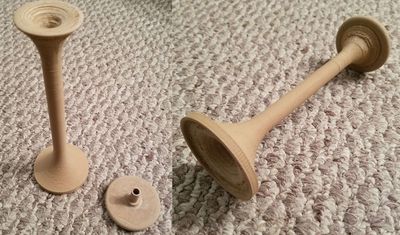Monaural Stethoscope
Project developed by Jordan LaFontaine
Template:Statusboxtop Template:Status-design Template:Status-prototype You can help Appropedia by contributing to the next step in this OSAT's status. Template:Boxbottom
Abstract
This design could fall under the 3rd "OSAT Sustainable Development Goal" for good health and well being. Strictly speaking, stethoscopes aren't required to listen to someones heartbeat. A trained professional could get the information they need simply by pressing their ear up against the patient's chest. However, a good stethoscope makes the process both easier and more comfortable. Here is a link to the original inspired design invented by Charles J.B. Williams around 1835: [1]

Bill of Materials
- The only required materials are a 3D printer and filament. Here is a link to the filament that was used for my prototype: [2]. A wooden composite material was used to mimic the original inspired design as close as possible. My guess (I could be wrong) is that a more porous material might muffle the sound as it passes through the stethoscope.
Tools needed for fabrication of the OSAT
- MOST Delta RepRap or similar RepRap 3-D printer
- [This is the used filament], however, other filaments should works as well.
Skills and Knowledge Necessary to Make the OSAT
- The main stethoscope works without the smaller piece. The purpose of the latter is not clear.
- could consider printing with support to bed
Technical Specifications and Assembly Instructions
- Layer Height: 0.2 mm
- Shell Thickness: 1 mm
- Bottom-Top thickness: 1 mm
- Fill Desnity 100%
- Print Speed: 70 mm/s
- Print Temperature (PLA): 205 C
- Flow: 100%
Print time estimate: 3 hours
The two parts should fit together with a little sanding/finesse. Be careful not to exert too much force or the smaller piece might break.
Common Problems and Solutions
- For the longer part, there was not very much surface area on the initial layer of the print. Therefore, it is very prone to breaking loose from the base, falling over and failing the print. One way to fix this would be to design a snap off layer in future iterations. For the prototype printed in this design, I had to manually hold the stethoscope in place for the upper layers.
Cost savings
- Estimated cost in filament is: $3.16
- Monaural stethoscopes don't seem to be manufactured anymore although you can purchase them from antique shops. Typical two ear stethoscopes vary widely in price but can be as cheap as $10.
- This design would save $6.84 or about 68%